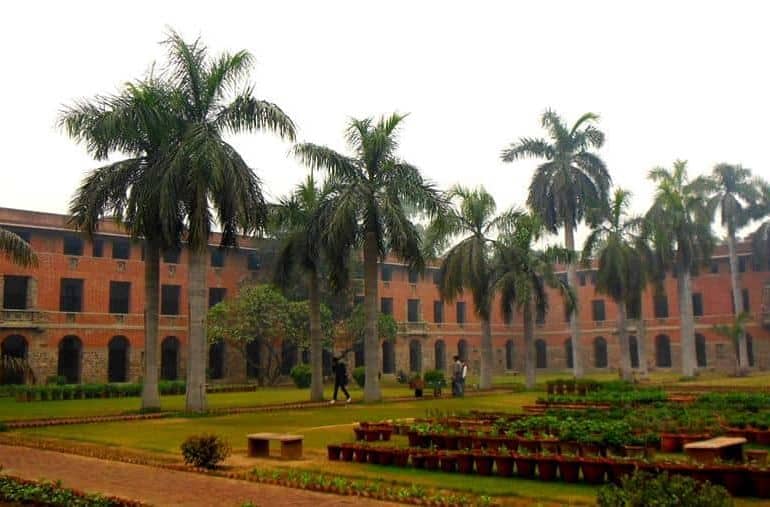On 17th January 2020, Miranda House hosted India Today’s Campus Face-off, which took a controversial turn after some students started protesting.
On 17th January 2020, India Today’s Rajdeep Sardesai and Aaj Tak’s Anjana Om Kashyap came to Miranda House for an edition of their show Campus Face-off. Campus Face-off is a special program where the anchors invite speakers from major parties, who debate and are questioned by the student audience. In Miranda House, they invited representatives from the three major parties of Delhi- Charu Pragya, Bhartiya Janata Party (BJP), Radhika Khera, Indian National Congress (INC) and Atishi Marlena, Aam Aadmi Party (AAP).
The anchors, Mr. Rajdeep Sardesai and Ms. Anjana Om Kashyap, conducted an informal session for 30 minutes before the taping, while waiting for the representatives of the parties to arrive. The anchors were asked questions on the current political scenario. When asked about the pressure on media, Ms. Kashyap replied, “Everybody’s perception of how news is being presented is different. We’ve become a very politically polarized country right now.” Rajdeep Sardesai also used this time to promote his new book How Modi Won India in 2019.
While the debate was to be on the issue of “Women Safety, Judgement on Nirbhaya Case, and other issues” in the face of upcoming elections, the panelists also discussed various other issues too, such as Kashmir, the violence in student campuses, economy and unemployment, and the controversial Citizenship (Amendment) Act-National Register of Citizens (NRC).
Mid-taping, a group of students stood up in the top-left corner of the room, and started silently protesting by holding up posters questioning police brutality, CAA-NRC, internet shutdowns, state of Kashmir, and such ongoing issues. The protestors, who were silent initially, started chanting, “Shame, Shame, Shame” on a comment made by the BJP representative denying the existence of the NRC. When the protestors began sloganeering, Mr. Sardesai asked them to come to the podium, and express themselves. The students expressed their discomfort at the suggestion saying that they stood as a collective, and asking one of them to represent them all would make that representative vulnerable to being targeted.
The protestors then moved to the centre of the room, near the podium, and began sloganeering again. A Kashmiri student then took to the podium and addressed the crowd in a very emotionally charged speech. “Do you know what is AFSPA? What about it’s victims? We are raped. Understand this… I am not against them (pointing to the panelists). I am against you all (pointing to the crowd). Shame on you… Fuck you. Fuck you sir. Fuck you three also.”
At this, Mr. Rajdeep Sardesai asked them to be removed from the taping, “Madam, you are allowed to speak your views, but you cannot hijack the program.” The Congress representative, then, came and stood with the protesting students.
“The face-off that took place yesterday at the Campus darkened the face of any form of dissent, dialogue, and debate that Miranda has known in the history of its existence. Yes, the anchors allowed questions, but what they also did was make the entire engagement futile… In the midst of it all, what actually suffered a setback was the culture of radical politics that Miranda prides itself on. The complacency, privilege and comfortable applause of the audiences stood out. The very audience that shamed and policed the tones of the voices of dissent in Miranda, never once questioned the nature of the ongoing debate and their lack of discussion on issues of the marginalized communities. The ones that gathered spine enough to register their protest on a platform as major as this have been let down. The culture of Miranda hangs its head in shame and silence. To begin with, it never was inclusive and ‘woke’ enough to accommodate the marginalized,” said a statement released by the Instagram handle, @mh_studentscollective.
View this post on InstagramWhat went wrong when India Today came to campus: A trajectory of events.
Anshula, a student present at the taping, said “ Rajdeep Sir, according to me, handled it professionally and asked them to protest silently if they want to. He asked them not to hijack the mic, saying there were other people also waiting to raise their concerns. I, too, support the cause, but feel like they could have used the platform better. They raised valid concerns and questions which are important to all of us, but using foul language invalidates the cause.”
The taping went on for more than two hours and ended around six in the evening.
Feature Image Credits: DU Beat Archives
Satviki Sanjay



